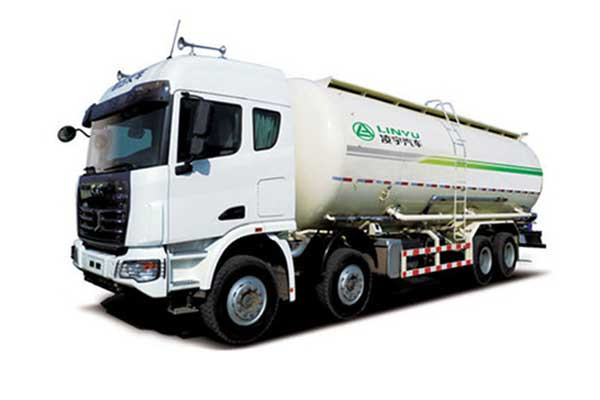The powder material transport vehicle, also known as the cement bulk carrier or the bulk cement truck, is composed of a special automobile chassis, a bulk cement vehicle tank body, a gas pipeline system, and an automatic unloading device. It is mainly used for bulk transportation of fly ash, cement, lime powder, ore powder, granular alkali and other dry materials with particle diameter not more than 0.1mm. We are often able to see such vehicle situations in cement plants, cement warehouses and large construction sites.
For special vehicles such as cement bulk carrier, the operation and maintenance are more complicated. Many details and key links require special attention. We start today with maintenance of cement bulk carrier to learn about the elimination of common faults in cement bulk carriers.
1. Car chassis: According to the selected car chassis instruction manual.
2. Air compressor: According to the specifications of the air compressor.
3, power take-off: always pay attention to regular inspection of its lubrication, operating conditions, if there is abnormal noise should be found out the reasons for timely elimination, annual gear occlusion and wear should be checked, and can not be overspeed.
4, gas path: should always check the sealing situation, if there is leakage in time to eliminate; often check the working condition of each valve, if the failure should be repaired or replaced; safety valve to ensure that the pressure is 0.2Mpa open, and the pressure inside the tank More than 0.2Mpa.
5. Tank body: Regularly check the tank weld seam for gas leakage. If this phenomenon is found, repair welding should be carried out in time.
6. Tank gas chamber: Check the air chamber canvas frequently. If it is moisture-tight or damaged, it should be replaced in time; check whether the air chamber pressure strip is compacted. If there is air leakage, it will affect the discharge effect and should be eliminated in time.
1. Before each uncovering of the feed inlet, the pressure relief valve and the intake pipe ball valve must be opened first. After the residual gas in the tank is removed, the material cover is opened to avoid accidents.
2, always pay attention to whether the pressure gauge is working properly, strictly prevent the pressure gauge from failing, overpressure, and the tank bursting leak.
3. Always check the safety valve to ensure that the pressure is reduced at 0.2Mpa, and the pressure inside the tank should not exceed 0.2Mpa.
4, often check whether the operating table is working properly, so as not to damage the air compressor and power take-off (specially refers to the powder tank bicycle).
5. Always listen to the sound of the power take-off and the air compressor. If there is abnormal noise, stop immediately to eliminate the fault.

1. Before unloading, check whether the discharge disc valve, external air source interface, exhaust valve and two inlets are closed and tightened. If not tightened, tighten first to prevent air leakage;
2. Start the engine and change the transmission to neutral. At the same time, press the clutch pedal to completely separate the transmission from the engine.
3. Open the power take-off solenoid valve switch and slowly release the clutch pedal to make the air compressor rotate;
4. Adjust the operating handle of the operating mechanism, adjust the speed of the air compressor to about 900r/min, and stabilize it;
5. When the pressure reaches 0.18MPa, first open the auxiliary blow pipe, then open the front and rear bin discharge disc valve to start unloading, after which the air compressor pointer will stabilize a certain value;
6. When the air pressure drops to 0.04Mpa, the rear bin has been unloaded, the blow-off pipe is closed, and the disc valve is closed several times after opening and closing. Then the rear disc valve and the rear tank intake valve are closed, that is, only the front bin is unloaded. After that, the pressure will rise and stabilize to a certain value;
7. When the pressure of the barometer reaches 0MPa, when the discharge is completed, close the air compressor (close the force switch) and close the discharge disc valve.
What are the small concrete mixer truck maintenance items?
What are the maintenance rules for new tank trucks?
Living up to your trust! CIMC Vehicles' DTB/Concrete Mixer Truck Business Group successfully concludes its 2025 delivery schedule.
2025-12-26 09:38Twenty pure electric concrete mixer trucks delivered; authoritative media in Zhumadian witness the industry's low-carbon upgrade.
2025-12-18 16:43100 units delivered, 1000 units achieved! CIMC Vehicles' DTB mixer truck business group, together with FAW Jiefang and CATL, jointly support Xinxiang's new journey of green development
2025-12-12 14:00CIMC Vehicles and Shaanxi Heavy Truck jointly launched their New Energy 4.0 products, deepening the new ecosystem of intelligent integrated trailer-mounted vehicles
2025-12-12 11:30Address:Zhangheng Street corner Guanlin Road, Science and Technology Park, Luolong District, Luoyang City, Henan Province
E-mail:shiyk@lingyu.com
Phone:0086-379-65937678